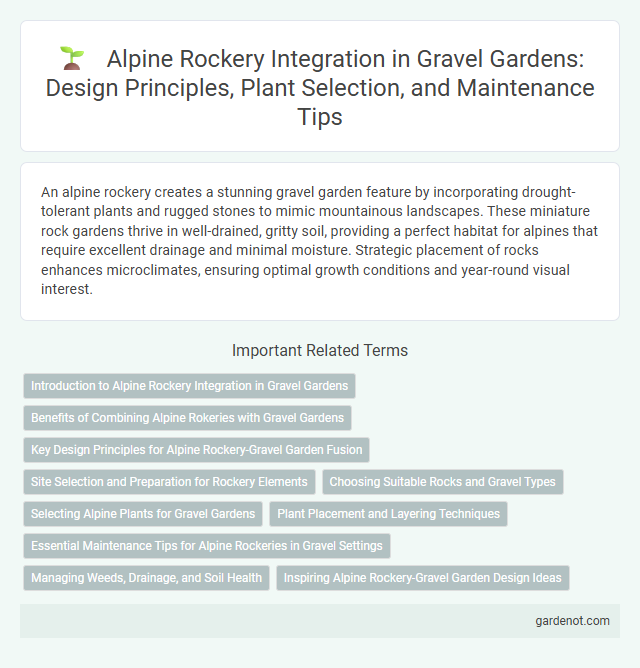An alpine rockery creates a stunning gravel garden feature by incorporating drought-tolerant plants and rugged stones to mimic mountainous landscapes. These miniature rock gardens thrive in well-drained, gritty soil, providing a perfect habitat for alpines that require excellent drainage and minimal moisture. Strategic placement of rocks enhances microclimates, ensuring optimal growth conditions and year-round visual interest.
Introduction to Alpine Rockery Integration in Gravel Gardens
Alpine rockery in gravel gardens offers a unique blend of rugged beauty and low-maintenance landscaping by incorporating drought-tolerant, small alpine plants among natural stone arrangements. These rockeries mimic mountainous environments, creating microhabitats for resilient species like saxifrage, sedum, and dianthus that thrive in well-drained, rocky soil conditions. Integrating alpine rockeries enhances biodiversity and adds year-round visual interest through textured foliage and seasonal blooms, perfectly complementing the minimalist aesthetic of gravel gardens.
Benefits of Combining Alpine Rokeries with Gravel Gardens
Combining alpine rockeries with gravel gardens creates a low-maintenance landscape that enhances water conservation through improved drainage and reduced soil erosion. Alpine plants thrive in the well-drained, mineral-rich environments provided by gravel beds, promoting healthy growth and vibrant seasonal blooms. This integration also increases biodiversity by attracting pollinators and beneficial insects, making it an eco-friendly and aesthetically pleasing garden design.
Key Design Principles for Alpine Rockery-Gravel Garden Fusion
Incorporate well-draining, gritty soil mixed with sharp sand and gravel to mimic natural alpine environments, ensuring optimal root aeration and moisture retention. Position stones strategically to create microclimates that protect delicate alpine plants from harsh weather while enhancing the gravel garden's texture and visual appeal. Select drought-resistant alpine species with shallow root systems to thrive in gravel substrates, maintaining biodiversity and structural harmony within the rockery.
Site Selection and Preparation for Rockery Elements
Choosing a well-drained, sunny location is essential for site selection when creating an alpine rockery in a gravel garden. Preparing the site involves removing weeds, adding a layer of coarse gravel or sand for drainage, and incorporating nutrient-poor, gritty soil to mimic natural alpine conditions. Proper site preparation ensures stable placement of rocks and promotes healthy growth of alpine plants adapted to rocky environments.
Choosing Suitable Rocks and Gravel Types
Selecting appropriate rocks for an alpine rockery involves prioritizing natural stone varieties such as granite, slate, or limestone, which provide durability and aesthetic appeal. Gravel types like coarse crushed stone or decomposed granite enhance drainage and complement the rugged texture of alpine plants. Optimal rock and gravel selection ensures proper water retention, root aeration, and mimics mountainous environments essential for alpine garden success.
Selecting Alpine Plants for Gravel Gardens
Choosing alpine plants for gravel gardens requires selecting species adapted to well-drained, rocky soils and full sun exposure. Suitable options include sedums, saxifrages, and alpine asters, which thrive in nutrient-poor, gritty substrates and provide year-round interest with their drought resistance and compact growth habits. Incorporating diverse textures and bloom times enhances both ecological benefits and visual appeal in alpine rockery designs.
Plant Placement and Layering Techniques
Alpine rockery in a gravel garden thrives with strategic plant placement that mimics natural mountainous terrain, using layering techniques to create depth and visual interest. Low-growing, drought-tolerant plants such as saxifrage and sedum are positioned in front, while taller, textured species like alpine asters and dwarf conifers are placed toward the back or elevated rock ledges. This arrangement maximizes sun exposure and drainage, essential for alpine species, while promoting biodiversity and aesthetic appeal through varied heights and textures.
Essential Maintenance Tips for Alpine Rockeries in Gravel Settings
Alpine rockeries in gravel gardens require regular watering to prevent drought stress, especially during dry spells. Ensuring proper drainage by using well-draining gravel substrates helps prevent root rot and promotes healthy growth. Periodic removal of weeds and dead foliage maintains aesthetic appeal and reduces competition for nutrients among alpine plants.
Managing Weeds, Drainage, and Soil Health
Alpine rockeries thrive in well-drained soil rich in organic matter, which prevents waterlogging and supports robust root systems. Managing weeds involves regular hand-pulling or using mulch to suppress growth without harming delicate alpine plants. Maintaining soil health requires occasional soil testing and amending with compost or grit to ensure optimal nutrient balance and drainage.
Inspiring Alpine Rockery-Gravel Garden Design Ideas
Alpine rockeries thrive in gravel gardens by combining well-drained substrates with drought-tolerant plants such as saxifrage, sedum, and alpine asters for a natural, rugged aesthetic. Incorporating varied rock sizes and textures enhances visual interest while promoting air circulation and moisture retention vital for alpine species. Strategic placement of native stones and succulents creates microclimates that mimic mountainous habitats, ensuring year-round resilience and low maintenance.
Alpine rockery Infographic

 gardenot.com
gardenot.com